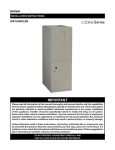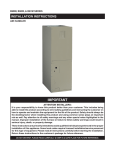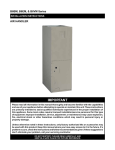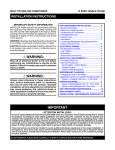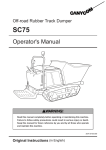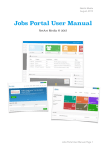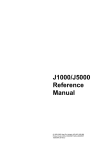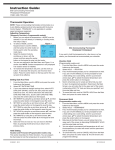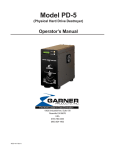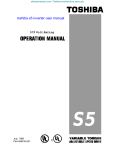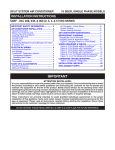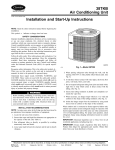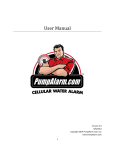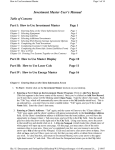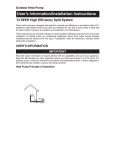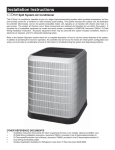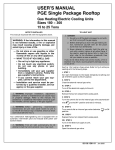Download B6BX air handler
Transcript
B6BX SERIES AIR HANDLER Installation Instructions IMPORTANT Please read all information in this manual thoroughly and become familiar with the capabilities and use of your appliance before attempting to operate or maintain this unit. These instructions are primarily intended to assist qualified individuals experienced in the proper installation of this appliance. Some local codes require licensed installation/service personnel for this type of equipment. Improper installation, service, adjustment, or maintenance may cause explosion, fire, electrical shock or other hazardous conditions which may result in personal injury or property damage. Unless otherwise noted in these instructions, only factory authorized kits or accessories may be used with this product. Keep this manual where you have easy access to it in the future. If a problem occurs, check the instructions and follow recommendations given. If these suggestions don’t eliminate your problem, call your servicing contractor. DO NOT DESTROY. PLEASE READ CAREFULLY AND KEEP IN A SAFE PLACE FOR FUTURE REFERENCE. TABLE OF CONTENTS Important Safety Information.....................................3 Requirements & Codes...............................................3 General Information....................................................4 Before You Install this Unit..........................................4 Locating the Air Handler.............................................4 Minimum Clearances..................................................4 Operation of Air Handler During Construction............4 Installation in a Garage..............................................5 Plenums & Air Ducts..................................................5 Unconditioned Spaces............................................5 Air Filters.................................................................5 Acoustical Duct Work..............................................5 Startup & Adjustments.............................................13 Before You Start the Unit..........................................13 Refrigerant Charging................................................14 Air Circulation...........................................................14 Running the Blower Continuously......................... 14 Selecting Continuous Low Spd Fan Operation..... 14 Turning the Blower Off..........................................14 System Cooling.....................................................14 System Heating.....................................................14 Blower Configurations..............................................14 3-Speed Units.......................................................14 5-Speed Units.......................................................14 Unit Maintenance.......................................................15 Troubleshooting.........................................................15 Air Handler Installation...............................................6 Packaging Removal....................................................6 Mounting Applications................................................6 Upflow Installations....................................................6 Downflow Installations................................................6 Horizontal Installations...............................................6 Horizontal Left Installations.....................................7 Horizontal Right Installations..................................7 Refrigerant Line Connections.....................................8 Orifice removal & Installation..................................8 Connecting the Linsets...........................................9 Condensate Drainage .............................................10 Figures & Tables........................................................16 Figure 12. B6BX Physical Dimensions..................16 Figure 13. B6BX Components..............................17 Electrical Connections..............................................11 Pre-Electrical Checklist............................................11 Line Voltage..............................................................11 Grounding................................................................11 Thermostat Connections..........................................11 Control Board...........................................................12 Twinning................................................................12 Heater Kits...............................................................12 Electronic Air Cleaner..............................................12 Humidifier.................................................................12 Installation / Performance Checklist........................24 2 Airflow Data..............................................................18 Table 3. B6BX Blower Performance Data..............18 Electrical Data & Diagrams......................................19 Table 4. B6BX MCA & MOP Data.........................19 Table 5. Control Board Operation..........................20 Table 6. Control Board Settings.............................20 Figure 14. W.D. with PSC Motor............................21 Figure 15. W.D. with ECM Motor...........................22 Important SAFETY INFORMATION INSTALLER: Please read all instructions before servicing this equipment. Pay attention to all safety warnings and any other special notes highlighted in the manual. Safety markings are used frequently throughout this manual to designate a degree or level of seriousness and should not be ignored. WARNING indicates a potentially hazardous situation that if not avoided, could result in personal injury or death. CAUTION indicates a potentially hazardous situation that if not avoided, may result in minor or moderate injury or property damage. WARNING: ELECTRICAL SHOCK, FIRE OR EXPLOSION HAZARD Failure to follow safety warnings exactly could result in serious injury or property damage. Improper servicing could result in dangerous operation, serious injury, death or property damage. • Before servicing, disconnect all electrical power to air handler. • When servicing controls, label all wires prior to disconnecting. Reconnect wires correctly. • Verify proper operation after servicing. WARNING: NITROGEN HEALTH 1 FLAMMABILITY 0 REACTIVITY 0 0 Minimal Hazard 1 Slight Hazard B6 Series Air Handlers leave the factory with a nitrogen holding charge. Use caution when preparing coils for field connections. If repairs make it necessary for evacuation and charging, it should only be attempted by qualified, trained personnel thoroughly familiar with this equipment. Some local codes require licensed installation service personnel to service this type of equipment. Under no circumstances should the equipment owner attempt to install and/or service this equipment. Failure to comply with this warning could result in equipment damage, personal injury, or death. Requirements & Codes WARNING: This unit must be installed in accordance with instructions outlined in this manual during the installation, service, and operation of this unit. Unqualified individuals should not attempt to interpret these instructions or install this equipment. Failure to follow safety recommendations could result in possible damage to the equipment, serious personal injury or death. • The installer must comply with all local codes and regulations which govern the installation of this type of equipment. Local codes and regulations take precedence over any recommendations contained in these instructions. Consult local building codes for special installation requirements. • This equipment contains nitrogen gas. Installation or servicing should only be performed by qualified trained personnel thoroughly familiar with this type equipment. • All electrical wiring must be completed in accordance with local, state and international codes and regulations. • Installation of equipment may require brazing operations. Installer must comply with safety codes and wear appropriate safety equipment (safety glasses, work gloves, fire extinguisher, etc.) when performing brazing operations. • Install this unit only in a location and position as specified on pages 4 & 5. This unit is designed only for Indoor installations and should be located with consideration of minimizing the length of the supply and return ducts. See Table 4 (page 18) and the rating plate for proper circulating airflow data. • Follow all precautions in the literature, on tags, and on labels provided with the equipment. Read and thoroughly understand the instructions provided with the equipment prior to performing the installation and operational checkout of the equipment. • This air handler may be used for temporary heating of buildings or structures under construction. See the guidelines listed on page 4. • Air handler installations in a residential garage must be installed as specified on page 5. 3 GENERAL INFORMATION This appliance has been tested for capacity and efficiency in accordance with AHRI 210/240 Standards and will provide many years of safe and dependable comfort, providing it is properly installed and maintained. Abuse, improper use, and/or improper maintenance can shorten the life of the appliance and create unsafe hazards. Please read all instructions before installing the unit. Before You Install this Unit √This equipment is securely packaged at the time of shipment and upon arrival should be carefully inspected for damage prior to installing the equipment at the job site. Claims for damage (apparent or concealed) should be filed immediately with the carrier. √ The cooling load of the area to be conditioned must be calculated and a system of the proper capacity selected. It is recommended that the area to be conditioned be completely insulated and vapor sealed. √ Check the electrical supply and verify the power supply is adequate for unit operation.The system must be wired and provided with circuit protection in accordance with local building codes. If there is any question concerning the power supply, contact the local power company. √ Verify the duct system is appropriate for the air handler being installed. Please note that when replacing an existing system with lower air-flow, the duct system may require modification. Locating the Air Handler • Survey the job site to determine the best location for mounting the unit. Consideration should be given to availability of electric power, service access, and noise. • The dimensions of the room or alcove must be able to accommodate the overall size of the unit and the installation clearances listed in Figure 1. Physical dimensions for this air handler are also shown in Figure 12 (page 16). • The air handler should be set into position before routing the refrigerant tubing. REAR 0 cm / in. LEFT SIDE 0 cm / in. RIGHT SIDE 0 cm / in. FRONT † See Note †NOTE: Alcove Installations - Allow 61 cm (24 in.) minimum clearance from front of unit to nearest wall or partition for servicing. Recommended clearance is 91 cm (36 in.). Figure 1. Minimum Unit Clearances 4 Minimum Clearances • This appliance must be installed in accordance with clearances listed in Figure 1. The air handler must be installed with ample clearance for easy access to the air filter, blower assembly, heater assembly and controls. Applicable building codes may require additional clearance to equipment. Refer to applicable building codes for details. • Static pressure drop through louvered openings and through return air plenums should be considered in the overall duct design in the determination of the total external static pressure. Operation of Air Handler During Construction CAUTION: Failure to follow these instructions will void the factory warranty and may significantly reduce the life or the performance of the air handler, and/or result in other unsafe conditions. It is the responsibility of the installing contractor to insure these provisions are met. Operating an air handler in a construction environment can cause the appliance a variety of problems. Proper use of commercial portable space heating equipment during construction is recommended. This air handler may be used during construction if it is not in violation of any applicable codes and the following criteria are met: • The installation must meet all applicable codes and be permanently installed according to the instructions supplied with the air handler including electrical supply and duct work. • The air handler must be controlled by a properly installed thermostat that complies with the current provisions of national and local electrical codes. Thermostat connections must be made in accordance with instructions supplied with the air handler and thermostat. See page 11. • The installation must include a properly installed filter in the return air system with no by-pass air. The filter must be inspected frequently and replaced when necessary. • Return air must be supplied unrestricted and located such that dust and gases from construction activity are not introduced into the circulating air system. • Before occupying the structure: The filter must be replaced or cleaned, the duct work must be inspected and cleaned of any construction debris, and the air handler must be cleaned and/or repaired if found to be dirty, damaged, or malfunctioning in any way by a qualified HVAC technician. The air handler shall be inspected and approved by applicable local authority even if this requires redundant inspections. • The serial number for the air handler used during construction must be submitted in writing (fax and email also acceptable). This information will be used to track the long-term affects of air handler usage during construction. Proof of this submittal shall be available for the final inspection of the air handler prior to occupancy. Installation in a Garage WARNING: Do not place combustible materials on or against the cabinet. Do not place flammable materials, (gasoline, paint thinners, etc.) or any other flammable vapors and liquids, in the vicinity of the air handler. The B6 Series air handler may be installed in a residential garage with the provision that the unit must be located or protected to prevent physical damage by vehicles. Plenums & Air Ducts WARNING: All return ducts must be secured to the air handler using appropriate methods. All return ducts must be adequately sealed. When return air is provided through the bottom of the unit, the joint between the air handler and the return air plenum must be air tight. Return air and circulating air ducts must not be connected to any other heat producing device such as a fireplace insert, stove, etc. This may result in fire, explosion, carbon monoxide poisoning, personal injury, or property damage. • Supply and return air must be delivered to the air handler by duct(s) secured to the air handler casing, running full size and without interruption. • This unit is designed only for use with a return and supply duct. The return air duct must have the same free area as the opening provided on the air handler. The ducts should be appropriately sized to the capacity of the air handler to ensure its proper airflow rating. Table 3 (page 18) contains the maximum airflow data listed by model. • Use transition fittings if the supply and/or return air openings of the unit do not match the duct openings. These transitions should be dimensioned in accordance with standard practice as specified in the ASHRAE recommendations for duct transitions. • Flexible connectors may be used between the unit and the ductwork to prevent transmission of vibration from the unit to the structure. If electric heater kits are installed, heat resistant material must be used for the flexible connector at the supply air end of the unit. • Seal all connections and joints with industrial grade sealing tape or liquid sealant. Requirements for sealing ductwork vary from region to region. Consult with local codes for specific requirements. Unconditioned Spaces All duct work passing through unconditioned space must be properly insulated to minimize duct losses and prevent condensation. Use insulation with an outer vapor barrier. Refer to local codes for insulation material requirements. Air Filters B6 Series Air Handlers are not supplied with an air filter when shipped from the factory. The installer must provide a high velocity filter that is appropriately sized to the return air duct opening or filter rack located in the bottom of the unit. Accessing the filter does not require tools and can be removed from the front of the unit by removing the filter door. See Unit Maintenance (page 15) for filter sizes and installation information. WARNING: Never operate the air handler without a filter or with doors removed. Dust and lint can build up on internal components, resulting in loss of efficiency, equipment damage, and possible fire. Acoustical Duct Work • Certain installations may require the use of acoustical lining inside the supply duct work. Acoustical insulation must be in accordance with all national and local codes for duct liners. Duct lining must be UL classified batts or blankets with a fire hazard classification of FHC-25/50 or less. • Fiber duct work may be used in place of internal duct liners if the fiber duct work is in accordance with all national and local codes. Fibrous duct work and internal acoustical lining must be NFPA Class 1 air ducts when tested per UL Standard 181 for Class 1 ducts. • Damping ducts, flexible vibration isolators, or pleated media-style filters on the return air inlet of the air handler may be used to reduce the transmission of equipment noise eminating from the air handler. These treatments can produce a quieter installation, particularly in the heated space. However, they can increase the pressure drop in the duct system. Care must be taken to maintain the proper maximum pressure rise across the air handler, temperature rise and flow rate. This may mean increasing the duct size and/or reducing the blower speed. These treatments must be constructed and installed in accordance with all national and local codes. For best sound performance, be sure to install all the needed gaskets and grommets around penetrations into the air handler, such as for electrical wiring. 5 Air handler INSTALLATION The B6 Series Air Handler is shipped ready for vertical upflow installation and is approved for attic, basement, alcove/closet or crawlspace installation with zero clearance to combustibles. See Figure 1 (page 4) for required installation clearances. This appliance is only for indoor use. • The unit must be leveled at installation and attached to a properly installed duct system. • The surface that the air handler is mounted on must provide sound physical support of the unit. • The air handler must be installed so that all electrical components are protected from water. • If a louvered door is installed across the front of this unit, the appliance must be mounted flush or behind front edge of finished wall. Horizontal Installations The B6 Series air handler can be installed horizontally in an attic, basement, crawl space or alcove. It can also be suspended from a ceiling in a basement or utility room in either a right to left airflow or left to right airflow as shown in Figure 4 (page 7). Air handlers may or may not be shipped from the factory with all the parts required for horizontal left applications and horizontal right applications. If your unit does not have parts for a horizontal application, a kit may be available. NOTE: In all horizontal applications in which the unit is installed above a finished ceiling and/or living space, a secondary drain pan must be installed under the entire unit to avoid damage to the ceiling in the event of condensate Packaging Removal Remove the shipping crate and User’s Manual from the equipment. When removing the crate, use extra care so tubing connections are not damaged. Do not pull on the coils upper tubes. Mounting Applications Vertical only air handlers are factory ready for upflow applications. These units may be applied in downflow discharge applications when applied with the appropriate field kit. Horizontal Drain Pan Factory ready horizontal air handlers may be applied in upflow or horizontal-left and -right discharge applications. These units may also be applied in downflow discharge when applied with the appropriate field kit as specified in the units Technical Specifications. Through-the-floor installations require a 1/4” thick noncombustible resilient gasket to be used whenever the supply or return air ducts pass through the floor.The gasket should be positioned between the duct, unit, and floor. Return Air Figure 2. Upflow Installation Upflow Installations All air handlers are factory shipped, ready for upflow installation. The horizontal drain pan may be removed from the air handler when installing the unit in an upflow configuration. All return air must enter from the bottom of the unit. A typical upflow unit is shown in Figure 2. Downflow Installations The downflow accessory kit (See Technical Specifications) is required for downflow applications. Instructions for installing the downflow accessory kit are included with the kit. It is recommended that the accessory be installed prior to installing the unit. All return air in downflow applications must enter through the top of the unit. A typical installation of the unit in a downflow application is shown in Figure 3. Cabinet Tube Close-off Plate Adaptor Kit Coil Figure 3. Downflow Installation 6 overflow. Additionally, it is recommended that an approved water level indicator or float switch device be used to shut down the unit in the event water is detected in the auxiliary drain pan. If suspending the air handler from the ceiling, assemble a support frame (Figure 5) using slotted iron channel and full threaded rod. Fasten the frame together with nuts, washers, and lockwashers. Secure the support frame to the rafters with lag bolts. The air handler can also be suspended using steel straps around each end of the unit. The straps should be attached to the air handler with sheet metal screws and to the rafters with bolts. Horizontal Left Installations: 1.Remove the coil access door. 2.Remove the plug from one of the threaded holes in the horizontal drain pan. Completely remove the webbing located in the threaded holes of the horizontal drain pan. IMPORTANT: If the webbing is not removed, the condensate will not drain properly and ceiling damage may occur. 3.Insert the plug (from horizontal drain pan) into the open and unused drain hole in the drain pan at the bottom of the unit to block bypass air. 4.Remove the corresponding drain line knockout from the coil access door to allow access to the horizontal drain. 5.Replace the door and attach the drain line. Horizontal Right Installations: 1.Remove the coil access door. Unscrew the line-set tube close-off plate from the front left cabinet rail. 2.Slide the coil and drain pan assembly out of the unit. 3.Remove the sheet metal hairpin covers (if supplied) from the back of the coil and discard. 4.Place the horizontal drain pan on the opposite side of the coil. On units with 2 sets of knockouts, remove the other set of knockouts in the coil spacing plates and insert support rod. 5.Slide the coil and the horizontal drain pan assembly back into the unit. Re-attach the tube close off plate. 6.Remove the plug from one of the threaded holes in the horizontal drain pan. Completely remove the webbing located in the threaded holes of the drain pan. IMPORTANT: If the webbing is not removed, the condensate will not drain properly and ceiling damage may occur. NOTE: It is recommended that the suction line be insulated up to the coil inside of the cabinet. 7.Insert the plug (from horizontal drain pan) into the open and unused drain hole in the drain pan at the bottom of the unit to block bypass air. 8.Remove the corresponding drain line knockout from the coil access door to allow access to the horizontal drain. 9.Replace the door and attach the drain line. HORIZONTAL RIGHT RETURN AIR Nuts (x2) HORIZONTAL LEFT RETURN AIR Threaded Rod Washer and Lockwasher Lag Bolt Nuts (x2) Figure 4. Horizontal Configurations Figure 5. Unit Horizontally Suspended 7 Refrigerant Line Connections WARNING: NITROGEN HEALTH 1 FLAMMABILITY 0 REACTIVITY 0 0 Minimal Hazard 1 Slight Hazard The coil in the air handler is factory shipped with a nitrogen charge. Avoid direct face exposure or contact with valve when gas is escaping. Always ensure adequate ventilation is present during the depressurization process. Address any uncertainties before proceeding. Failure to comply with this warning could result in equipment damage, personal injury, or death. • The installer should make every effort to ensure the field installed refrigerant containing components of the system have been installed in accordance with these instructions and sound installation practices for reliable system operation and longevity. • The air handler coil does not contain a refrigerant charge. Refer to the installation instructions supplied with the outdoor unit for refrigerant charge information. • Always refer to the installation instructions supplied with the outdoor unit for piping requirements. The suction and liquid lines must be sized in accordance with the condensing unit specifications. See Figure 12 (page 16) for liquid and suction line locations. • When connecting refrigerant linesets together, it is recommended that dry nitrogen be flowing through the joints during brazing. This will prevent internal oxidation and scaling from occurring. • Refrigerant tubing should be routed in a manner that minimizes the length of tubing and the number of bends in the tubing. It should be supported in a manner that prevents it from vibrating or abrading during system operation. Tubing should be kept clean of foreign debris during installation. • If precise forming of refrigerant lines is required, a copper tubing bender is recommended. Avoid sharp bends and contact of the refrigerant lines with metal surfaces. • Refrigerant lines should be wrapped with pressure sensitive neoprene or other suitable material where they pass against sharp sheet metal edges. • B6BX series air handlers are charged through service valves on the end of the liquid tube for each circuit. These must be removed before brazing the line sets. 8 Orifice Removal & Installation The orifice installed in the air handler has been sized for use with the most popularly matched outdoor units. The orifice size as shipped from the factory is listed on the air handler rating plate. Perform steps 1 - 9 to confirm that the orifice size meets the requirements outlined in the outdoor unit installation manual. 1.Remove the cap from the end of the liquid line. 2.Verify pressurization by depressing the Schrader valve on the end of the liquid line. Listen for any escaping gas. If there is no pressure, test the coil for leakage. • If leakage is found, clearly mark the location of the leak and return the coil to the distributor for processing. • If no leaks are found, the coil may be installed. 3.Depress the valve to relieve all pressure from the coil. 4.Remove and discard the valve core. CAUTION: To prevent damage to the unit or internal components, it is recommended that two wrenches be used when loosening or tightening nuts. Do not over tighten! 5.Using two wrenches, loosen the nut and distributor body as shown in Figure 6. Turn the assembly nut counterclock-wise until the orifice body halves are seperated. Figure 6. Loosening of Nut & Distributor Body 6.Insert a light-gauge wire hook between the distributor body and the restrictor orifice while being careful not to scratch either part. Carefully remove the restrictor orifice from the distributor body. See Figure 7 (page 9). 7.Check the actual size of the new orifice. NOTE: The size is stamped on its side. Do not use pin gauges to measure the orifice diameter. 8.Insert the new orifice into the distributor body, rounded end down. See Figure 8 (page 9). Connecting the Linesets Figure 7. Removal of Orifice IMPORTANT NOTES FOR HORIZONTAL OR DOWNFLOW INSTALLATIONS WITH TXV VALVE: • The sensing bulb must be located flush against the suction line for optimum heat transfer. • Avoid attaching the sensing bulb to the lowest part of the suction line where condensate may accumulate. • Do not locate the sensing bulb on vertical sections of the lineset. • For horizontal lines, the bulb should not be located at 12 or 6 o’clock position of the suction line. The best location is at 4 or 8 o’clock. • For additional information on proper sensing bulb locations, please refer to the valve manufacturer’s instructions. IMPORTANT:The steps in the Orifice Removal & Installation section (page 8) must be performed before the linesets are connected. 1.Remove grommets from line set holes. CAUTION: Figure 8. Restrictor Insertion into Distributor Body CAUTION: To prevent damage to the unit or internal components, it is recommended that two wrenches be used when loosening or tightening nuts. Do not over tighten! 9.Realign the assembly nut on the distributor body and hand tighten both components. Mark a line on both bodies and then tighten an additional 1/4 turn using two wrenches. The movement of the two lines will show how much the nut is tightened. If a torque wrench is used, tighten to 14-16 Nm (10-12 ft. lbs.). It is recommended that a wet rag be wrapped around the suction line in front of the close off plate or the sensing bulb (if TXV is installed) before applying heat. Failure to keep components cool during brazing may result in structural damage, premature equipment failure, or possible personal injury. 2.Remove the rubber plug from the suction line. 3.Cut the Schroeder housing from the end of the liquid line. Verify the end is round, clean and free of any burrs. 4.Route and cut both lineset tubes to proper length in accordance with the outdoor unit specifications. Verify the ends are round, clean, and free of any burrs. 5.Position grommet on line set with sufficient distance away from brazing area. Brazing processes can permanently damage grommets. 6.Connect the suction and liquid lineset tubes. CAUTION: It is recommended that a wet rag be wrapped around the suction line in front of the close off plate or the sensing bulb (if TXV is installed) before applying heat. Failure to keep components cool during brazing may result in structural damage, premature equipment failure, or possible personal injury. 7.Braze the individual connections with dry nitrogen flowing through the joints. NOTE: This will prevent internal oxidation and scaling from occurring. 9 8.Wrap the refrigerant lines with pressure sensitive neoprene or other suitable material especially where the lines enter the opening in the sheet metal. 9.Evacuate the system of moisture and non-condensables to prevent low efficiency operation or damage to the unit. The suggested range of evacuation is 350 - 500 microns. 10.Charge the system with refrigerant. Refer to the outdoor unit installation manual for additional charging instructions. 11.Check the system for leaks, including the lineset and the brazed joints. 12.Replace all grommets and properly dispose of all removed parts. Condensate Drainage CAUTION: The air handler must be level to ensure proper condensate drainage. An unlevel installation may result in structural damage, premature equipment failure, or possible personal injury. • Methods for disposing of condensate vary according to local codes. Refer to local codes or authority having jurisidiction for restrictions and proper condensate disposal requirements. • The drain pan that is supplied with this air handler contains a primary and secondary drain fitting. The condensate is drained from the unit through two 1.9 cm (3/4”) female pipe fittings located on the front side of the unit as shown in Figure 9. • The drain pan must be drained with field supplied tubing or pvc pipe and adequately trapped. Both drain tubes must have a minimum diameter of 1.9 cm (3/4”) and be trapped separately. • If the air handler is located in or above a living space where damage may result from condensate overflow, an auxiliary drain pan shall be installed under the unit. A separate drain line should extend from the pan to a conspicuous point and serve as an alarm indicating that the primary drain is restricted. As an alternative to a separate drain line, an approved water level indicator or float switch device may be used to shut down the unit in the event water is detected in the auxiliary pan. • Install a single 12.7 cm (5 inch) trap in the condensate drain line as close to the coil as possible. Make sure that the top of the trap is below the bottom of the drain pan to prevent the condensate from overflowing the drain pan. NOTE: There must be only one trap in the drain line. Using more than one trap may prevent drainage. • Prime the trap with water. Insulate the drain if it is located in an unconditioned space, and test the condensate line for leaks. Consult local codes for additional restrictions or precautions. • During system checkout, inspect the drain line and connections to verify proper condensate drainage. UPFLOW HORIZONTAL 1.9 cm (3/4 in.) Adapter w/ 1.9 cm (3/4 in.) dia. hose barb DOWNFLOW 1.9 cm (3/4 in.) minimum dia. PVC or flexible tubing IMPORTANT: Failure to install a trap may result in condensation overflowing the drain pan, resulting in substantial water damage to surrounding area. • Route both lines to a suitable drain, avoiding sharp bends and pinching of the lines. The drain should maintain a minimum horizontal slope in the direction of discharge of not less than 2.5 cm (1”) vertical for every 3.048 M (10 ft) of horizontal run. NOTES: 1. The drain lines must maintain a downward slope to ensure proper condensate drainage. 2. Each condensate drain must be trapped separately using a J-Trap or field supplied loop. Figure 9. Condensate Drainage Example 10 ELECTRICAL connections WARNING: ELECTRICAL SHOCK, FIRE OR EXPLOSION HAZARD Failure to follow safety warnings exactly could result in serious injury or property damage. Improper servicing could result in dangerous operation, serious injury, death or property damage. • Before servicing, disconnect all electrical power to the air handler. • When servicing controls, label all wires prior to disconnecting. Reconnect wires correctly. • Verify proper operation after servicing. Pre-Electrical Checklist √Verify the voltage, frequency, and phase of the supply source match the specifications on the unit rating plate. √ Verify that the service provided by the utility is sufficient to handle the additional load imposed by this equipment. See the unit wiring label or Table 4 (page 19) for proper high and low voltage wiring. √ Verify factory wiring is in accordance with the unit wiring diagram (Figures 14 & 15, pages 21 & 22). Make sure the connections didn’t loosen during shipping or installation. Line Voltage • Electrical connections must be in compliance with all applicable local codes and ordinances. • An electrical disconnect must be located within sight of and readily accessible to the unit. This switch shall be capable of electrically de-energizing the outdoor unit. See unit data label for proper incoming field wiring. Any other wiring methods must be acceptable to authority having jurisdiction. • It is recommended that the line voltage to the unit be supplied from a dedicated branch circuit containing the correct fuse or circuit breaker for the unit. • Overcurrent protection must be provided at the branch circuit distribution panel and sized as shown on the unit rating label and according to applicable local codes. See the unit rating plate and Table 4 (page 19) for minimum circuit ampacity and maximum overcurrent protection limits. • The installer should become familiar with the wiring diagram/schematic before making any electrical connections to the unit. See the unit wiring label or Figures 14 & 15 (pages 21 & 22). • Use only copper wire for the line voltage power supply to this unit. Use proper code agency listed conduit and a conduit connector for connecting the supply wires to the unit. Aluminum supply wire may be used if a heater kit is installed. • If replacing any of the original wires supplied with the unit, the replacement wire must be copper wire consisting of the same gauge and temperature rating. • Provide power supply for the unit in accordance with the unit wiring diagram, and the unit rating plate. Use UL listed conduit and conduit connectors for connecting the supply wires to the unit and for proper grounding. Field supplied bushings for the power supply cables must be added to support and protect the power supply cables. • All 208/230 Volt units are shipped from the factory wired for 240 volt operation. For 208V operation, remove the lead from the transformer terminal marked 240V and connect it to the terminal marked 208V. Grounding WARNING: The unit cabinet must have an uninterrupted or unbroken electrical ground to minimize personal injury if an electrical fault should occur. Do not use gas piping as an electrical ground! This unit must be electrically grounded in accordance with local codes. Use the grounding lug provided in the control box for grounding the unit. Thermostat Connections • Thermostat connections shall be in accordance with the instructions supplied with the thermostat. The thermostat used with this equipment must operate in conjunction with any installed accessories. Typical AC and air handler hookups are shown in Figure 11 (page 13). CAUTION: Isolation must be maintained from the external Class 2 output of any transformer in a cooling circuit. Use a thermostat with isolating contacts to prevent inter-connection of Class 2 outputs. • Where local codes require that the thermostat wiring must be routed through a conduit or raceway, splices can be made inside the unit; however, all wiring must be NEC Class 1 and must be separated from incoming power leads. • The thermostat should be mounted about 1.5 Meters (5 feet) above the floor on an inside wall. DO NOT install the thermostat on an outside wall or any other location where its operation may be adversely affected by radiant heat from fireplaces, sunlight, or lighting fixtures, and convective heat from warm air registers or electrical appliances. Refer to the thermostat manufacturer’s instruction sheet for detailed mounting and installation information. • Install the grommet, which is packed with the unit, in the hole for low-voltage wires. Properly connect the 11 low-voltage wiring between the thermostat, outdoor unit, and control board. NOTE: When the low voltage wires are positioned in this grommet, the grommet will prevent chafing and/or shorting of the low voltage leads. Control Board The control board in the air handler controls the timing sequence of the elements. The board is equipped with a 3 second blower on delay and a 15 second blower off delay in heating and a 40 second blower off delay in cooling. See Figures 14 or 15 (pages 21-22) and Table 5 (pages 20) for control board operation. Twinning B6BX air handlers are not supplied with a built in twinning capability. To connect two air handlers to a common single stage AC condensing unit or heat pump, a twinning kit is available for field installation. Please follow the instructions supplied with the kit. NOTE: Variable speed air handlers cannot be twinned. Heater Kits When electric heat packages with circuit breakers are field-installed, the circuit breaker may be used as a disconnecting means in most applications. Reference the NEC and local codes for disconnect requirements. If a heater kit is installed: The B6BX air handler is shipped from the factory without an electric heater kit installed. If Electric heat is desired, the H6HK heater kit may be purchased separately and field installed. Determine the correct size heater kit for your unit by referring to the list below or the units rating label. A Cabinet........................................................ 15Kw max B Cabinet........................................................ 20Kw max C Cabinet........................................................ 30Kw max 1.Connect the 2 wire plug of the air handler to the mating 2 wire plug of the heater kit. 2.Connect the line voltage leads to the circuit breaker or terminal block provided. 3.Connect the heater kit plug with the mating receptacle on the air handler control board. If a heater kit is not installed: 1.Remove the 2 wire plug of the air handler by cutting the wires and discarding the plug. 2.Strip the ends of the 2 air handler wires and connect to the line-voltage leads with the 2 wire nuts provided. Electronic Air Cleaner (EAC) The unit has an output to power an electronic air cleaner when the blower is running. This output is rated to 1.0 amp at 208/240V. Humidifier The unit has an output to power a humidifier when the blower is running. This output is rated to 1.0 amp at 208/240V. Y P2 R C G W R C G W Y 3A Fuse 3A Fuse P2 BLWDTC BLWDTC_R 5 4 3 2 1 1 23 45 L2 CONTROL BOARD FOR A & B CABINET L1 L1 CONTROL BOARD FOR C CABINET L2 EAC COOL HEAT LED 1 LED 1 HEATER P1 HEATER P1 Figure 10. B6BX Control Boards 12 Startup & Adjustments Thermostat WARNING: WYG R NITROGEN Air Handler Air Conditioner W1 Y Y C Typical Air Conditioner with Standard Air Handler Thermostat W2 O Y G R C E NOTE: Jumper between W2 & E is required when no OD T-Stat is used. O W1 W2 Y Y G R R C FLAMMABILITY 0 REACTIVITY 0 1 Slight Hazard The evaporator coil is shipped from the factory with a nitrogen charge. Use caution when preparing coils for field connections. If repairs make it necessary for evacuation and charging, it should only be attempted by qualified, trained personnel thoroughly familiar with this equipment. Some local codes require licensed installation service personnel to service this type of equipment. Under no circumstances should the equipment owner attempt to install and/or service this equipment. Failure to comply with this warning could result in equipment damage, personal injury, or death. R Air Handler 1 0 Minimal Hazard G C HEALTH C Heat Pump Typical Heat Pump with Standard Air Handler Figure 11. Typical Thermostat Connections Before You Start the Unit Prior to start-up, complete the following inspections: √ Verify the unit is level and properly located with adequate clearances for servicing the unit. See Figure 1 (pg 4). √Check condensate drain line(s) for proper drainage. √Verify the surrounding area and top of the unit is free from obstructions and debris. √Check all duct connections. Make sure the duct work is adequately sealed to prevent air leakage. √Check all coil connections for leaks. √Verify that the line voltage power leads are securely connected and the unit is properly grounded. Make sure all doors are installed before restoring power to the unit √ Verify the thermostat is wired correctly. Make sure all low voltage wires are securely connected. √Verify the power supply branch circuit overcurrent protection is sized properly. √Verify filter is properly and securely installed. IMPORTANT: Before starting the unit, install the initial charge on units that are factory shipped with a nitrogen holding charge: 1.Read all installation instructions first. 2.Purge the nitrogen holding charge. 3.Evacuate the unit to 350 - 500 microns. 4.Allow the unit to remain under vacuum for at least 30 minutes. 5.Weigh in the proper amount of new (or reclaimed) refrigerant. Refer to the air conditioner or heat pump installation manual for the proper type and quantity of refrigerant. 13 Refrigerant Charging The system refrigerant charge can be checked and adjusted through the service ports provided at the front panel of the outdoor unit. Use only gauge lines which have a Schrader depression device present to actuate the valve. Air Circulation Running the Blower Continuously Set the thermostat’s system mode to OFF and the thermostat’s fan mode to ON. The blower motor should run continuously. Check for air delivery at the register(s). Ensure that there are no obstructions at the registers or in the ducts. Selecting continuous low speed fan operation (Standard Blower) The air handler is equipped with an option of continuous low speed fan operation. When G is energized without Y/ Y2, the air handler will operate using the cooling speed. With G & Y/Y2 or Y/Y2 energized, the air handler will operate in the selected cooling speed (including 40 sec blower-off delay). Turning the Blower Off Set thermostat’s fan mode to AUTO, the blower will shut down immediately. System Cooling 1. Set the thermostat’s system mode to COOL and fan mode to AUTO. Lower the thermostat’s temperature mode below room temperature and observe that the blower energizes. Check the air being discharged at the register is cooler than room temperature. Verify unit refrigerant pressures are in order. Blower should be turning in direction indicated by arrow. NOTE: DO NOT alter unit wiring. Listen for any unusual noises. Locate the source and correct as needed. 2. Allow the unit to run for several minutes and then set the thermostat’s temperature above room temperature. Verify the blower cycles off with the thermostat. System Heating 1. Set the thermostat’s system mode to HEAT and the fan mode to AUTO. Increase the thermostat’s temperature above room temperature and observe that the blower energizes. Check the air being discharged at the register is warmer than room temperature. 2. Allow the unit to run for several minutes and then set the thermostat’s temperature below room temperature. Verify the blower cycles off with the thermostat. 14 Blower Configurations 3-Speed Units The blower speed is preset at the factory for operation at the same speed for heating and cooling, by using the jumping terminal on the blower motor and connecting it to the desired speed with both the red and black wires connected to the jumping terminal. NOTE: The control board is programmed with a 40 second off delay in the cooling mode for optimum system performance and efficiency. CAUTION: To avoid personal injury or property damage, make sure the motor leads do not come into contact with any uninsulated metal components of the unit. For optimum system performance and comfort, it may be necessary to change the factory set speed. See Table 3 (page 18) for airflow data. To change the blower speed: 1.Disconnect all electrical power to the unit and remove the upper door. 2.Remove the black and red wires from the blower motor jumping terminal. Discard the blower motor jumping terminal. 3.Connect the heating speed wire (red) and the cooling speed wire (black) to the desired blower speed marked on the terminal block of the blower motor. • Terminal 4 = Hi speed • Terminal 5 = Med speed • Terminal 6 = Low speed 4.Replace the upper door and secure it to the unit. 5.Restore power to the unit. 5-Speed Units Blower speed can be selected by setting the switches on the control board. See Table 6 (page 20). UNIT MAINTENANCE Proper maintenance is most important to achieve the best performance from a air handler. Some of the components and their locations are shown in Figure 12 (page 17). If any component of the air handler must be replaced, use only factory authorized replacement parts specified in the Replacement Parts List provided online. Cabinet Size Filter Size A 30.5 cm x 50.8 cm x 2.5 cm (12 in. x 20 in. x 1 in.) B 45.7 cm x 50.8 cm x 2.5 cm 18 x 20 x 1 C 50.8 cm x 50.8 cm x 2.5 cm 20 x 20 x 1 WARNING: ELECTRICAL SHOCK, FIRE OR EXPLOSION HAZARD Failure to follow safety warnings exactly could result in serious injury or property damage. Improper servicing could result in dangerous operation, serious injury, death or property damage. • Before servicing, disconnect all electrical power to air handler. • When servicing controls, label all wires prior to disconnecting. Reconnect wires correctly. • Verify proper operation after servicing. • These maintenance instructions are primarily intended to assist qualified technicians experienced in the proper maintenance and operation of this appliance. • Always reinstall the doors on the air handler after servicing or cleaning/changing the filters. Do not operate the air handler without all doors and covers in place. • Verify that the thermostat is properly installed and is not being affected by drafts or heat from lamps or other appliances. • To achieve the best performance and minimize equipment failure, it is recommended that a yearly maintenance checkup be performed. At a minimum, this check should include the following items: Air Filter(s) B6 Series Air Handlers are not supplied with an air filter when shipped from the factory. It is recommended that the filter be cleaned or replaced monthly. Newly built or recently renovated homes may require more frequent changing until the construction dust has minimized. Filter sizes shown in Table 1 are available at most local retailers. WARNING: Never operate the air handler without a filter in place. Dust and lint in the return air can build up on internal components, resulting in loss of efficiency, equipment damage, and possible fire. Table 1. Filter Sizes Blower Compartment Dirt and lint can create excessive loads on the motor resulting in higher than normal operating temperatures and shortened service life. It is recommended that the blower compartment be cleaned of dirt or lint that may have accumulated in the compartment or on the blower and motor as part of the annual inspection. Blower Fan Wheel Inspect the blower wheel blades for accumulations of dirt and clean if necessary. Inspect mounting nut for tightness when done. Blower Motor & Assembly Inspect the blower assembly and motor mounting brackets for tightness and corrosion. Correct deficiencies if necessary. The blower motor contains sealed bearings and under normal operating conditions, no maintenance is necessary for the life of the equipment. TROUBLESHOOTING If the air handler fails to operate, check the following: • Is the electric turned on? • Is the thermostat operating properly? • Are the blower compartment door(s) in place? • Is the air handler disconnect closed? • Has the circuit breaker tripped or the control board fuse burned open? • Are any manual reset switches open? • Is the filter dirty or plugged? • Is the LED on the air handler control board constantly ON? If not, refer to Table 2 to determine fault condition. Red LED (AN2) Diagnostic OFF Control Fault (No Power) Flash Blower Fault ON Normal Operation Table 2. Air handler Control Board Fault Conditions Filters designed to remove smaller particles such as pollen, may require additional maintenance. 15 Figures & Tables 1.9 (3/4) 2.9 (1 1/8) Knockout (typ.) 1.9 (3/4) 33 (13) 3.2 (1 1/4) “A” 4.8 (1 7/8) Knockout 4.1 (1 5/8) 4.8 (1 7/8) 6.7 (2 5/8) 4.8 (1 7/8) 1.9 (3/4) 3.2 (1 1/4) 8.3 (3 1/4) 2.9 (1 1/8) Knockout (typ.) 2.9 (1 1/8) 9.2 (3 5/8) 14.3 (5 5/8) 4.8 (1 7/8) 2.4 (7/8) K.O. DETAIL “D” 4.4 mm (1 3/4) Knockout (typ.) “H” 8.3 (3 1/4) 5.7 (2 1/4) 38.7 (15 1/4) SUCTION LIQUID 33 (13) “W” 55.9 (22) Cabinet Size H W A Detail D A B 110 (43 5/16) 36 (14 3/16) 32.4 (12 3/4) No 110 (43 5/16) 50 (19 11/16) 46.4 (18 1/4) No Tall B 126 (49 5/16) 50 (19 11/16) 46.4 (18 1/4) No C 142 (55 15/16) 57 (22 7/16) 53.3 (21) Yes NOTE: All Dimensions shown as cm (inches). Figure 12. B6BX Physical Dimensions 16 Circuit Breaker (60A) Heating Element Assembly Transformer Motor Control Board Upper Door Assembly Blower Wheel Control Board Capacitor Motor Mount Kit Blower Housing Coil Assembly Horizontal Drain Pan Blower Motor Filter Door Vertical Drain Pan Filter Tracks Lower Door Assembly Figure 13. B6BX Components 17 AIRFLOW DATA Dry Coil ESP 018E-A 024/030E-B 036/042E-B 048/060E-C .25 (0.1) .5 (0.2) .76 (0.3) 1.0 (0.4) 1.3 (0.5) 1.5 (0.6) 2.0 (0.8) LOW 296 (627) 270 (572) 234 (496) N/A N/A N/A N/A N/A MED 348 (737) 321 (680) 293 (620) 247 (523) 215 (456) N/A N/A N/A HIGH 434 (920) 403 (853) 365 (774) 328 (694) 261 (554) 228 (484) N/A N/A Dry Coil ESP .25 (0.1) .5 (0.2) .76 (0.3) 1.0 (0.4) 1.3 (0.5) 1.5 (0.6) 1.8 (0.7) 2.0 (0.8) LOW 531 (1125) 509 (1079) 480 (1018) 447 (948) 406 (860) 352 (745) 287 (609) 203 (430) MED 610 (1293) 580 (1228) 546 (1157) 506 (1072) 463 (980) 406 (861) 336 (712) 248 (526) HIGH 692 (1466) 655 (1387) 615 (1304) 570 (1207) 521 (1103) 465 (985) 390 (827) 303 (641) Dry Coil ESP .25 (0.1) .5 (0.2) .76 (0.3) 1.0 (0.4) 1.3 (0.5) 1.5 (0.6) 1.8 (0.7) 2.0 (0.8) LOW 695 (1473) 662 (1403) 626 (1327) 585 (1240) 541 (1146) 496 (1051) 434 (919) 346 (733) MED 726 (1539) 691 (1463) 655 (1387) 611 (1295) 565 (1196) 517 (1095) 458 (970) 372 (789) HIGH 755 (1599) 721 (1528) 680 (1441) 639 (1353) 590 (1249) 536 (1136) 480 (1018) 392 (830) Dry Coil ESP .25 (0.1) .5 (0.2) .76 (0.3) 1.0 (0.4) 1.3 (0.5) 1.5 (0.6) 1.8 (0.7) 2.0 (0.8) M1 712 (1509) 737 (1562) 757 (1603) 782 (1657) 803 (1702) 826 (1749) 846 (1793) 865 (1832) M2 785 (1663) 807 (1709) 826 (1750) 850 (1801) 872 (1848) 890 (1885) 913 (1934) 932 (1974) 963 (2041) 983 (2082) 1003 (2126) 1025 (2172) M3 894 (1894) 910 (1928) 923 (1956) 940 (1992) M4 973 (2062) 986 (2088) 999 (2117) 1016 (2153) 1032 (2187) 1045 (2214) 1062 (2251) 1078 (2284) M5 996 (2110) 1011 (2143) 1022 (2165) 1036 (2194) 1052 (2229) 1068 (2262) 1085 (2299) 1100 (2331) NOTES: 1) Airflow is shown in liter’s per second (cfm) +/- 5%. 2) External static pressure is shown in cm (inches) W.C. 3) All airflows are measured with filter and with dry coil. For wet coil, subtract .1” external static pressure. 4) See unit nameplate or installation instructions for maximum recommended external static pressure. Table 3. B6BX Blower Performance Data 18 1.8 (0.7) Electrical data & Diagrams 220 VAC 50Hz, Single Phase -048/060E-C -036/042E-B -024/030E-B -018E-A Aux. Heat Installed (Nom. KW) Single Circuit 240 VAC 50Hz, Single Phase Multiple Circuit Circuit A Circuit B Circuit C Single Circuit Multiple Circuit Circuit A Circuit B Circuit C MCA MOP MCA MOP MCA MOP MCA MOP MCA MOP MCA MOP MCA MOP MCA MOP None 5 1.6 24.5 15 25 1.6 24.5 15 25 - - - - 1.6 26.6 15 30 1.6 26.6 15 30 - - - - 8 37.9 40 37.9 40 - - - - 41.2 45 41.2 45 - - - 10 47.4 50 47.4 50 - - - - 51.6 60 51.6 60 - - - - 15 70.3 80 47.4 50 22.92 25 76.6 80 51.6 60 25 25 - - 20 N/A N/A N/A N/A N/A N/A N/A N/A N/A N/A N/A N/A N/A N/A N/A N/A 25 N/A N/A N/A N/A N/A N/A N/A N/A N/A N/A N/A N/A N/A N/A N/A N/A N/A 30 N/A N/A N/A N/A N/A N/A N/A N/A N/A N/A N/A N/A N/A N/A N/A None 2.6 15 2.6 15 - - - - 2.6 15 2.6 15 - - - - 5 25.5 30 25.5 30 - - - - 27.6 30 27.6 30 - - - - 8 38.9 40 38.9 40 - - - - 42.2 45 42.2 45 - - - - 10 49.5 50 49.5 50 - - - - 52.6 60 52.6 60 - - - - 15 71.4 80 49.5 50 22.92 25 - - 77.6 80 52.6 60 25 25 - - 20 94.3 100 49.5 50 36.67 50 - - 102.6 110 52.6 60 50 50 - - 25 N/A N/A N/A N/A N/A N/A N/A N/A N/A N/A N/A N/A N/A N/A N/A N/A 30 N/A N/A N/A N/A N/A N/A N/A N/A N/A N/A N/A N/A N/A N/A N/A N/A None 3.6 15 3.6 15 - - - - 3.6 15 3.6 15 - - - - 5 26.5 30 26.5 30 - - - - 28.6 30 28.6 30 - - - - 8 39.9 40 39.9 40 - - - - 43.2 45 43.2 45 - - - - 10 49.5 50 49.5 50 - - - - 53.6 60 53.6 60 - - - - 15 72.4 80 49.5 50 22.92 25 - - 78.6 80 53.6 60 25 25 - - 20 95.3 100 49.5 50 36.67 50 - - 103.6 110 53.6 60 50 50 - - 25 N/A N/A N/A N/A N/A N/A N/A N/A N/A N/A N/A N/A N/A N/A N/A N/A N/A 30 N/A N/A N/A N/A N/A N/A N/A N/A N/A N/A N/A N/A N/A N/A N/A None 8.3 15 8.3 15 - - - - 7.7 15 7.7 15 - - - - 5 31.3 30 31.3 30 - - - - 32.7 30 32.7 30 - - - - 8 44.6 45 44.6 45 - - - - 47.3 50 47.3 50 - - - - 10 54.2 60 54.2 60 - - - - 57.7 60 57.7 60 - - - - 15 77.1 80 54.2 60 22.92 25 - - 82.7 90 57.7 60 25 25 - - 20 100.0 110 54.2 60 36.67 50 - - 107.7 110 57.7 60 50 50 - - 25 30 106.7 145.8 125 150 54.2 54.2 60 60 36.67 36.67 50 50 22.92 36.67 25 50 132.7 157.7 150 175 57.7 57.7 60 60 50 50 50 50 25 50 25 50 Table 4. B6BX Minimum Circuit Ampacity & Maximum Overcurrent Protection 19 Control Signal & MODE Operation Total KW 5 KW Stage 1 Heat on instantly Heat blower on after 3 second delay 10 KW Stage 1 Heat on instantly Heat blower on after 3 second delay Stage 2 Heat on after 5 seconds delay ON W (EHEAT) Heat stages off instantly Blower off after 15 second delay OFF 5 KW Stage 1 Heat on instantly Cool blower on after 3 second delay 10 KW Stage 1 Heat on instantly Cool blower on after 3 second delay Stage 2 Heat on after 5 seconds delay ON W &Y (AUX HEAT) G (FAN) Y (H.P. & COOL) Board Action OFF Heat stages off instantly Heat blower turns off after 40 second delay ON Cool blower on after 3 second delay OFF Cool blower off instantly ON Cool Blower on after 3 second delay OFF Cool Blower off after 40 second delay Table 5. Control Board Operation HEAT COOL SET 5 4 3 2 1 1 2 3 4 5 M1 OFF OFF OFF OFF ON ON OFF OFF OFF OFF M2 OFF OFF OFF ON OFF OFF ON OFF OFF OFF M3 OFF OFF ON OFF OFF OFF OFF ON OFF OFF M4 OFF ON OFF OFF OFF OFF OFF OFF ON OFF M5 ON OFF OFF OFF OFF OFF OFF OFF OFF ON Table 6. Control Board Settings 20 Field Wiring Factory Wiring: Low Voltage High Voltage Legend IF BOARD EQUIPPED WITH BLWDTC TERMINAL BLACK R BLW DTC Air Handler B6BX YELLOW W G C HEATER PLUG 7654321 Y R WHITE GREEN GRAY RED WIRING DIAGRAM RELAY 5-PIN PLUG (18) 3A VDE FUSE RELAY Figure 14. Wiring Diagram for B6BX Series Air Handler with PSC Motor 21 L2 L1 R C L1 L2 HEAT COOL EAC 2 1 RED BLACK CAP. BROWN BROWN RED 3-SPEED 208 240 R 6 5 4 3 2 1 BLACK GRAY 24 V C TRANSFORMER COM MOTOR 1=COM 2=CAP. 3=CAP. 4=HI 5=MED 6=LOW WHITE RED WHITE BLACK CUT WIRES TO REMOVE PLUG HOUSING WHEN HEATER KIT NOT INSTALLED LOCATION OF “T” CONNECTOR 01/12 7112150 NOTES: 1. The blower motor speed tap connection may not be as shown. See the Installation Instructions. 2. Disconnect all power before servicing. 3. Transformer may have a dual voltage primary tap. Match the tap position with the supply voltage used. 4. If the internal wiring is replaced, use only 105°C copper wire of the same gauge. Figure 15. Wiring Diagram for B6BX Series Air Handler with ECM Motor 22 LEGEND: FIELD WIRING LOW VOLTAGE HIGH VOLTAGE WHITE HEATER YELLOW C RED W G GRAY ON OFF R COOL 2 6 1 5 7 3 8 4 5432112345 HEAT CONTROL BOARD Y GREEN NOTES: 1. The blower motor speed tap connection may not be as shown.Refer to installation instructions provided with unit to set DIP switches for the appropriate heating and cooling speed setting for your application. B6BX ECM WIRING WIRING DIAGRAM DIAGRAM L2 L2 L1 L1 L1 L2 C R GRAY RED YELLOW BLACK WHITE BROWN BLACK WHITE ECM MOTOR 208V TRANSFORMER 240V 24V YELLOW/GREEN ORANGE BLUE RED BLACK RED GRAY Single Phase/50Hz 0811 7111780 2. Disconnect all power before servicing. 3. The transformer may have a dual voltage primary tap. Match the tap position with the supply voltage used. 4. If the internal wiring is replaced, use only 105°C copper wire of the same gauge. 208/240 Volt 23 INSTALLATION / PERFORMANCE CHECK LIST ELECTRICAL SYSTEM: ATTENTION INSTALLERS: It is your responsibility to know this product better than your customer. This includes being able to install the product according to strict safety guidelines and instructing the customer on how to operate and maintain the equipment for the life of the product. Safety should always be the deciding factor when installing this product and using common sense plays an important role as well. Pay attention to all safety warnings and any other special notes highlighted in the manual. Improper installation of the air handler or failure to follow safety warnings could result in serious injury, death, or property damage. These instructions are primarily intended to assist qualified individuals experienced in the proper installation of this appliance. Some local codes require licensed installation/service personnel for this type of equipment. Please read all instructions carefully before starting the installation. Return these instructions to the customer’s package for future reference. Electrical connections tight? YES NO Line voltage polarity correct? YES NO Supply Voltage: ___________________________________(V) Has the thermostat been calibrated? YES NO Is the thermostat level? YES NO INSTALLER NAME: CITY: STATE: INSTALLATION ADDRESS: CITY: STATE: UNIT MODEL # UNIT SERIAL # Minimum clearances per page 4? YES NO Is the unit properly installed and leveled? YES NO Does condensate drain properly in both drain tubes? YES NO Has the owner’s information been reviewed with the home-owner? YES NO Has the literature package been left near the appliance? YES NO Specifications & illustrations subject to change without notice or incurring obligations. O’ Fallon, MO | Printed in U.S.A. (01/12) 709333A (Replaces 7093330)
























